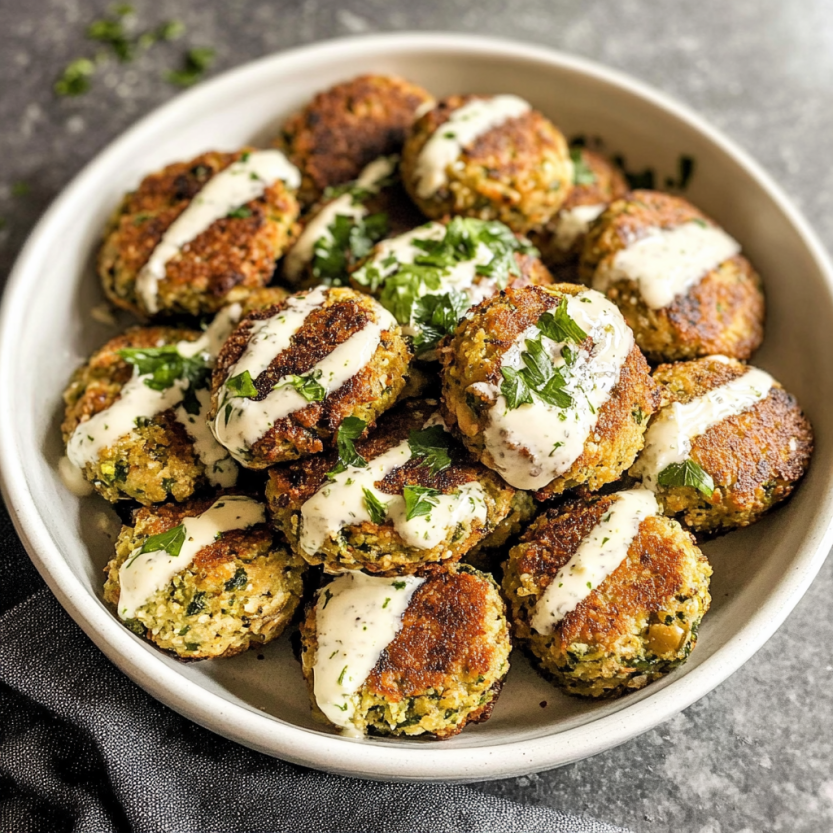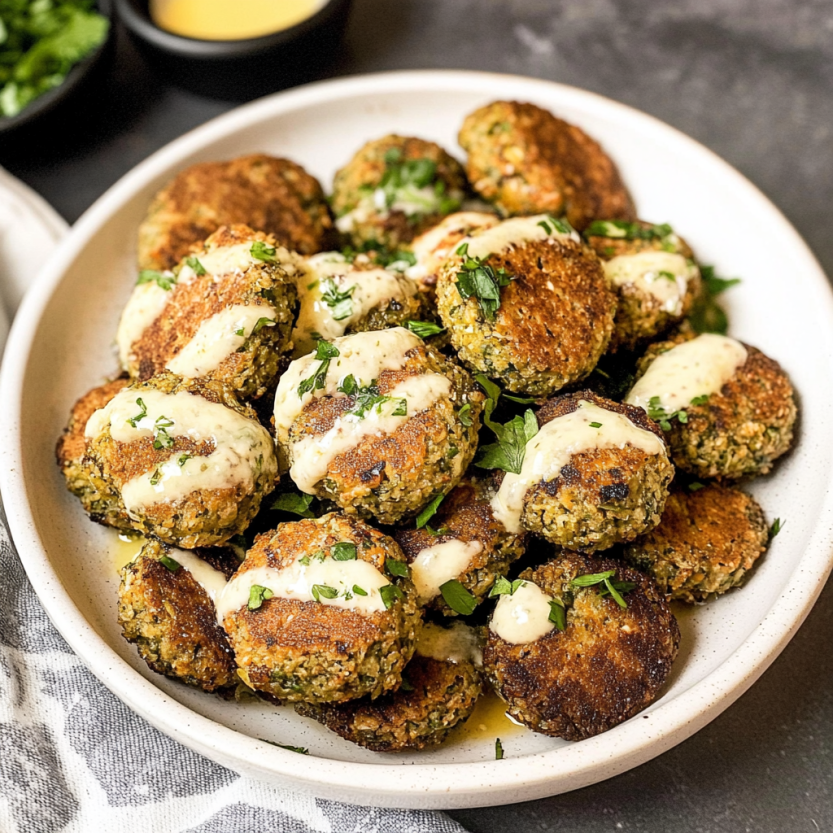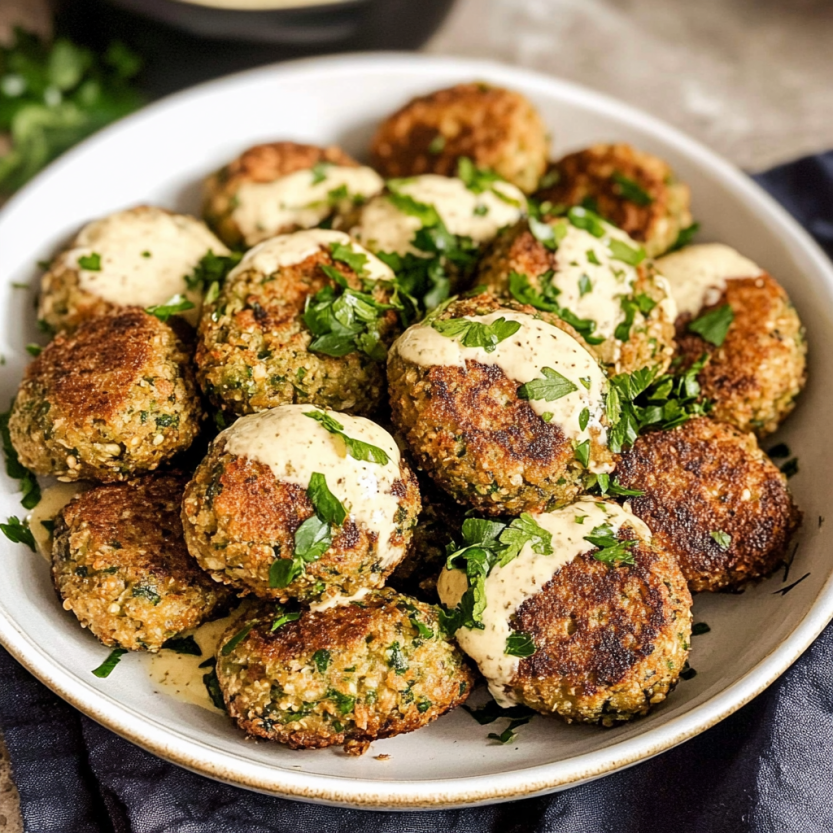 Bookmark
Bookmark
This traditional falafel recipe delivers perfectly crispy exteriors with fluffy, herb-infused interiors that put store-bought versions to shame. After years of experimenting with Middle Eastern cuisine, I've perfected these protein-packed chickpea fritters that have become a staple for both casual family dinners and impressive entertaining.
I discovered this recipe during a cooking class in Tel Aviv and have spent years refining it to match those incredible street food versions. My vegetarian daughter requests these weekly, claiming they're better than our local Mediterranean restaurant.
Ingredients
- Dried chickpeas: soaked overnight crucial for authentic texture and proper binding never use canned
- Small onion: adds moisture and savory depth choose sweet varieties for best flavor
- Fresh garlic: provides essential aromatic foundation use fresh cloves not pre-minced
- Parsley cilantro and dill: this trio creates the signature herbaceous profile and beautiful green interior
- Ground cumin: the quintessential falafel spice that provides earthy warmth
- Cardamom or Italian seasoning: adds subtle complexity and depth
- All purpose flour: optional ingredient that helps bind mixture if too wet
- Baking soda: creates the light airy interior texture that defines great falafel
- Vegetable oil: for frying choose a neutral oil with high smoke point
- Tahini sauce: for serving enhances the nutty flavors in the falafel
Step-by-Step Instructions
- Soak the Chickpeas:
- Place dried chickpeas in a large bowl completely submerged in water and soak for at least 8 hours or overnight. The chickpeas will double in size and should feel firm but not crunchy when done. This step is absolutely non negotiable for authentic falafel.
- Process the Mixture:
- Drain soaked chickpeas thoroughly and add to your food processor along with onion garlic fresh herbs and all seasonings. Pulse in short bursts stopping to scrape down sides until you achieve a fine texture that resembles coarse sand. The mixture should hold together when pinched but still maintain some texture.
- Finish the Batter:
- Transfer processed mixture to a bowl and incorporate flour if needed and baking soda. Mix thoroughly with a spatula ensuring even distribution of ingredients. The mixture should be moist but hold its shape when formed. If too wet add additional flour a teaspoon at a time.
- Rest and Chill:
- Cover the bowl with plastic wrap and refrigerate for at least 30 minutes. This crucial resting period allows flavors to meld and the mixture to firm up making it easier to shape. Longer chilling yields even better flavor development.
- Shape the Falafel:
- Wet your hands slightly to prevent sticking and form mixture into uniform 1 inch balls. Apply gentle pressure to compact them without crushing. For consistent sizing use a small ice cream scoop or tablespoon measure as a guide.
- Fry to Perfection:
- Heat oil to 350°F in a deep pot the oil should be at least 2 inches deep. Test with a small piece of mixture it should sizzle immediately but not violently. Fry in small batches without overcrowding turning occasionally until deeply golden brown about 2 3 minutes.
- Drain and Serve:
- Remove falafel with a slotted spoon and place on paper towel lined plate to absorb excess oil. Allow to cool slightly before serving as they will continue to crisp up as they cool. Serve warm with tahini sauce and fresh herbs.
 Bookmark
Bookmark
The key ingredient that elevates homemade falafel is fresh dill, which many recipes omit. My Lebanese neighbor taught me this secret, explaining that dill adds brightness that balances the earthiness of chickpeas. When my children were young, they would help shape the falafel balls, turning cooking into a family activity that created lasting memories.
Storage Wisdom
Falafel separates professionals from amateurs in how it's stored and reheated. For maximum freshness, store cooled falafel in an airtight container with paper towels between layers to absorb any moisture. They'll maintain quality in the refrigerator for up to 5 days. For longer storage, freeze uncooked falafel mixture in portioned balls on a baking sheet, then transfer to freezer bags once solid. They can be cooked directly from frozen, adding just 1-2 minutes to frying time.
Authentic Serving Traditions
In Middle Eastern cuisine, falafel is rarely eaten alone. Create a traditional spread by serving in warm pita pockets with tahini sauce, Israeli salad (diced cucumber, tomato, and onion), pickled turnips, and hot sauce. For a lighter option, serve over a bed of hummus with olive oil drizzle, or atop a substantial salad with lemon-tahini dressing. The contrast between warm falafel and cool, crunchy vegetables creates the perfect textural balance.
 Bookmark
Bookmark
Common Pitfalls Avoided
The biggest mistake home cooks make with falafel is using canned chickpeas, which contain too much moisture and create a mushy interior that falls apart during frying. Another common error is overprocessing the mixture into a smooth paste rather than maintaining some texture. Finally, frying at too low a temperature causes falafel to absorb excess oil and become greasy. Using a cooking thermometer to maintain 350°F oil temperature ensures perfect results every time.
Frequently Asked Questions About Recipes
- → Why use dried chickpeas instead of canned?
Dried chickpeas are essential for authentic falafel texture. Canned chickpeas contain too much moisture and are already cooked, resulting in a mushy interior and falafel that falls apart during frying. Raw dried chickpeas (soaked but not cooked) create the perfect consistency that holds together and yields the traditional fluffy interior.
- → Can I make falafel ahead of time?
Yes! You can prepare the falafel mixture up to 2 days ahead and keep it refrigerated. You can also form the balls and refrigerate them on a lined tray for several hours before cooking. Fully cooked falafel can be stored in an airtight container in the refrigerator for 4-6 days and reheated in the oven or air fryer to restore crispiness.
- → What's the best way to serve falafel?
Traditional serving options include falafel wrapped in pita bread with tahini sauce, lettuce, tomatoes and pickles. You can also serve them on a mezze platter with hummus, tabbouleh, and pita bread. For a modern twist, add them to salad bowls with mixed greens, cucumber, and tzatziki sauce, or serve as appetizers with various dipping sauces.
- → How can I tell when the oil is ready for frying?
The oil should be heated to approximately 350°F (175°C). If you don't have a thermometer, test by dropping a small piece of the falafel mixture into the oil - it should sizzle immediately and rise to the surface, surrounded by bubbles. If it sinks and doesn't bubble vigorously, the oil isn't hot enough. If it immediately browns or burns, the oil is too hot.
- → Why did my falafel fall apart during frying?
Falafel typically falls apart when the mixture is too wet or wasn't chilled properly. Make sure to thoroughly drain soaked chickpeas before processing. Adding 1 tablespoon of flour can help bind the mixture if it seems too wet. Always refrigerate the mixture for at least 30 minutes before shaping, and ensure your oil is hot enough before frying to create a quick outer seal.
- → Can I freeze homemade falafel?
Yes! Both uncooked and cooked falafel freeze well. For uncooked falafel, form the balls and place them on a baking sheet in the freezer until solid, then transfer to a freezer bag for up to 3 months. For cooked falafel, cool completely before freezing in an airtight container. Thaw in the refrigerator overnight and reheat in a 350°F oven for best results.
